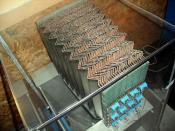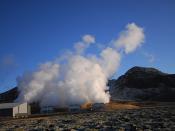This specific experiment was about utilizing a calorimeter to measure specific heat capacity of different solutions and elements.
H+ + OH- <-> H2O
NH4NO3(s) NH4+ (aq) + NO3-(aq)
The Ccal represents the specific heat of the calorimeter, it basically measures how much heat is required to raise the temperature by one degree measurement of temperature, within the calorimeter. It is important to measure it twice because we can see if the calorimeter is giving us an accurate measurement. Our first Ccal value was 29.1 kJ/mol while the second one was 33.5. kJ/mol.While they were not perfect they were fairly consistent and they make sense. Because we started the second trial with hotter water than we did with the first.
The value of the Cmetal was 0.44 meaning that the unknown metal was nickel. The calculated atomic mass was 57.2 g while the true atomic mass was 58.7g.
So, the calculated atomic mass was very close to the true one.
The experimental change in enthalpy for part 3 was 28.6 kJ/mol while the true change in enthalpy was slightly lower at 27.0kJ/mol. These two numbers are fairly close together. In part 4 however the calculated change in enthalpy was -55.53 kJ/mol while the experimental change was very far off at -7.7 kJ/mol. The change in enthalpies were very far off.
The error in part 4 could have been caused by failing to take accurate assessments of the change in temperature at the correct. Perhaps a mistake was made with the calculation of the change in enthalpy. The large discrepancy could also have been caused by not adding mixing an accurate amount of HCl and NaOH together.


